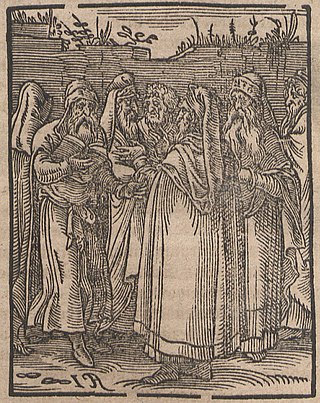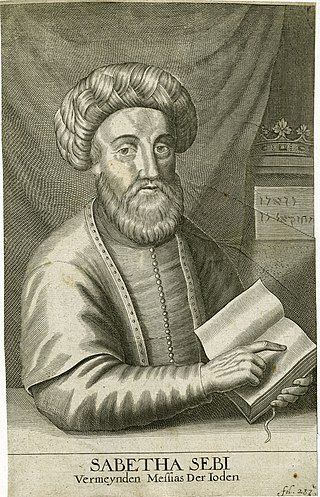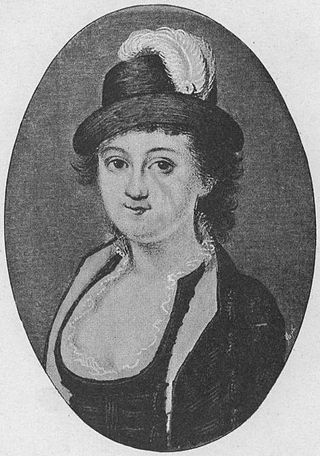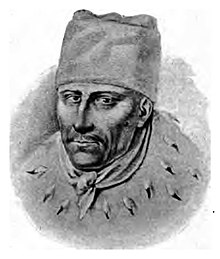
Kabbalah or Qabalah is an esoteric method, discipline and school of thought in Jewish mysticism. A traditional Kabbalist is called a Mekubbal. The definition of Kabbalah varies according to the tradition and aims of those following it, from its origin in medieval Judaism to its later adaptations in Western esotericism. Jewish Kabbalah is a set of esoteric teachings meant to explain the relationship between the unchanging, eternal God—the mysterious Ein Sof —and the mortal, finite universe. It forms the foundation of mystical religious interpretations within Judaism.

The Sabbateans were a variety of Jewish followers, disciples, and believers in Sabbatai Zevi (1626–1676), a Sephardic Jewish rabbi and Kabbalist who was proclaimed to be the Jewish Messiah in 1666 by Nathan of Gaza.

Jacob Joseph Frank was a Polish-Jewish religious leader who claimed to be the reincarnation of the self-proclaimed messiah Sabbatai Zevi (1626–1676) and also of the biblical patriarch Jacob. The Jewish authorities in Poland excommunicated Frank and his followers due to his heretical doctrines that included deification of himself as a part of a trinity and other controversial concepts such as neo-Carpocratian "purification through transgression".

Sabbatai Zevi was an Ottoman Jewish mystic, false messiah and ordained rabbi from Smyrna. He was likely of Ashkenazi origin. Active throughout the Ottoman Empire, Zevi claimed to be the long-awaited Jewish Messiah and founded the Sabbatean movement.
Apostasy in Judaism is the rejection of Judaism and possible conversion to another religion by a Jew. The term apostasy is derived from Ancient Greek: ἀποστάτης, meaning "rebellious" Equivalent expressions for apostate in Hebrew that are used by rabbinical scholars include mumar, poshea Yisrael, and kofer. Similar terms are meshumad, and min or Epikoros, which denote heresy and the negation of God and Judaism, implying atheism.

Gershom Scholem was a German-born Israeli philosopher and historian. Widely regarded as the founder of modern academic study of the Kabbalah, Scholem was appointed the first professor of Jewish mysticism at Hebrew University of Jerusalem.
Ein Sof, or Eyn Sof, in Kabbalah, is understood as God prior to any self-manifestation in the production of any spiritual realm, probably derived from Solomon ibn Gabirol's term, "the Endless One". Ein Sof may be translated as "unending", "(there is) no end", or infinity. It was first used by Azriel, who, sharing the Neoplatonic belief that God can have no desire, thought, word, or action, emphasized by it the negation of any attribute. Of the Ein Sof, nothing ("Ein") can be grasped ("Sof"-limitation). It is the origin of the Ohr Ein Sof, the "Infinite Light" of paradoxical divine self-knowledge, nullified within the Ein Sof prior to creation. In Lurianic Kabbalah, the first act of creation, the Tzimtzum self "withdrawal" of God to create an "empty space", takes place from there. In Hasidic Judaism, the Tzimtzum is only the illusionary concealment of the Ohr Ein Sof, giving rise to monistic panentheism. Consequently, Hasidism focuses on the Atzmus divine essence, rooted higher within the Godhead than the Ein Sof, which is limited to infinitude, and reflected in the essence (etzem) of the Torah and the soul.
Jonathan Eybeschutz was a Talmudist, Halachist, Kabbalist, holding positions as Dayan of Prague, and later as Rabbi of the "Three Communities": Altona, Hamburg and Wandsbek. He is well known for his conflict with Jacob Emden in the Emden–Eybeschutz Controversy.
Jacob Querido was the successor of the self-proclaimed Jewish Messiah Sabbatai Zevi. Born in Thessaloniki, he was the son of Joseph the Philosopher and brother of Jochebed, Shabbatai Zevi's last wife. Jochebed claimed that he was the reincarnation of her late spouse, so that he might succeed to the leadership of Sabbatai's followers. He attracted a considerable following of his own, called Ya‘qōviyīm or Yakubiler.

The Dönme were a group of Sabbatean crypto-Jews in the Ottoman Empire who converted outwardly to Islam, but retained their Jewish faith and Kabbalistic beliefs in secret. The movement was centered mainly in Thessaloniki. It originated during and soon after the era of Sabbatai Zevi, a 17th-century Sephardic Jewish Rabbi and Kabbalist who claimed to be the Jewish Messiah and eventually feigned conversion to Islam under threat of death from the Sultan Mehmed IV. After Zevi's forced conversion to Islam, a number of Sabbatean Jews purportedly converted to Islam and became the Dönme. Some Sabbateans lived on into 21st-century Turkey as descendants of the Dönme.

Nathan of Gaza, also Nathan Benjamin ben Elisha Hayyim haLevi Ashkenazi or Ghazzati, was a theologian and author born in Jerusalem. After his marriage in 1663 he moved to Gaza, where he became famous as a prophet for the Jewish messiah claimant Sabbatai Zevi.
Lurianic Kabbalah is a school of Kabbalah named after Isaac Luria (1534–1572), the Jewish rabbi who developed it. Lurianic Kabbalah gave a seminal new account of Kabbalistic thought that its followers synthesised with, and read into, the earlier Kabbalah of the Zohar that had disseminated in Medieval circles.
Moses Pinheiro was an Italian Jew who lived in Livorno in the seventeenth century. He was one of the most influential pupils and followers of Sabbatai Zevi.

Eve Frank or Eva Frank born Rachel Frank in Nikopol, Ottoman Empire, was a mystic cult leader, and the only woman to have been declared a Jewish messiah according to historian Jerry Rabow. She was the daughter of Jacob Frank, the claimant to the position of Jewish messiah in the 18th century, and allegedly Sophie Ascania/Catherine the Great.
Abraham Rovigo was a Jewish scholar, rabbi and kabbalist.
Meir bar Hiyya Rofe was a Hebron rabbi, known among other things for his tours of Europe as an emissary from the Holy Land on behalf of the Jewish community of Hebron. His father, Hiyya Rofe, was a very learned rabbi from Safed. Orphaned at a young age, Meir studied in Hebron, leaving about 1648 as an emissary to Italy, Holland, and Germany. On his return journey, he stayed for two years in Italy to publish Ma'aseh Ḥiyya, his father's talmudic novellae and responsa. In Amsterdam he had influenced the wealthy Abraham Pereyra to found a yeshiva in Hebron to be called Hesed le-Avraham, of which Meir himself became the head scholar.
Kabbalah, the central system in Jewish mysticism, uses anthropomorphic mythic symbols to metaphorically describe manifestations of God in Judaism. Based on the verses "God created man in his own image, in the image of God created he him; male and female created he them" and "from my flesh shall I see God", Kabbalah uses the form of the human body to describe the structure of the human soul, and the nature of supernal Divine emanations. A particular concern of Kabbalah is sexual unity between male and female potencies in Divinity on high, depicted as interaction of the two sides in the sephirot, between archetypal partzufim, and the redemption of the exiled Shekhinah from captivity among the impure forces below.
Samuel Primo, was a prominent Sabbatean sectarian of the 17th century.

Yehuda Liebes is an Israeli academic and scholar. He is the Gershom Scholem Professor Emeritus of Kabbalah at the Hebrew University of Jerusalem. He is considered a leading scholar of Kabbalah; his other research interests include Jewish myth, Sabbateanism, and the links between Judaism and ancient Greek religion, Christianity, and Islam. He is the recipient of the 1997 Bialik Prize, the 1999 Gershom Scholem Prize for Kabbalah Research, the 2006 EMET Prize for Art, Science and Culture, and the 2017 Israel Prize in Jewish thought.







